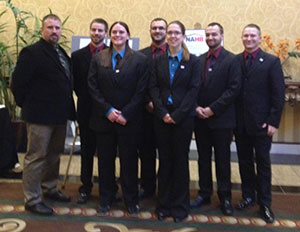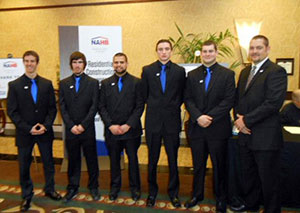Penn College Students Fare Well Amid High-Profile Competition
Tuesday, April 9, 2013
Students from construction majors and several other disciplines skillfully represented Pennsylvania College of Technology during competition at the National Association of Home Builders International Builders’ Show recently held in Las Vegas.
A team of students from four-year majors finished 12th out of 31 schools in the HBI Residential Construction Management Competition, and their two-year counterparts captured ninth place in a field of 16. Entrants representing universities, community colleges, high schools, and career and technical schools take part in the annual competition, in which students solve real-life residential construction problems and present their solutions to a judging panel of industry experts.
“Our four-year team had its best finish as far as anyone can remember,” said Levon A. Whitmyer, instructor of building construction technology and co-adviser. “I was completely happy with the results. The students worked so hard, and we made a great showing at the competition. Even the judges made comments about how well we improved over last year.”
 Team members (representing three academic schools at Penn College), their hometowns and majors are: Samantha L. Werner, Quakertown, and Daniel H. Palkovic, Kingston, residential construction technology and management: building construction technology concentration; Keith D. Vandegrift, Quakertown, residential construction technology management; Sean A. Herman, Milton, civil engineering technology; Cory L. Buckles, South Williamsport, business administration: small business and entrepreneurship concentration; and Erin M. Smith, South Williamsport, business administration: marketing concentration.
Team members (representing three academic schools at Penn College), their hometowns and majors are: Samantha L. Werner, Quakertown, and Daniel H. Palkovic, Kingston, residential construction technology and management: building construction technology concentration; Keith D. Vandegrift, Quakertown, residential construction technology management; Sean A. Herman, Milton, civil engineering technology; Cory L. Buckles, South Williamsport, business administration: small business and entrepreneurship concentration; and Erin M. Smith, South Williamsport, business administration: marketing concentration.
This year’s construction problem for the four-year competition focused on the feasibility of developing and building homes on a 118-acre site in Saratoga Springs, Utah. Teams submitted proposals in advance, then prepared to defend for the judges their floor plans, construction estimates/budgets, schedules, cash-flow projections, project management and organization plans, marketing and risk analyses, site and land-development plans, and “green” building initiatives.
“The students worked very hard on this project from mid-September until the end of the fall semester,” Whitmyer said. “I didn’t actually keep track, but I believe the students had over 400 hours into this project – especially team leader Samantha Werner.”
That dedication wasn’t lost on officials: Werner was one of 44 Outstanding Student competitors chosen from among the institutions attending. HBI, formerly known as the Home Builders Institute, administers the NAHB’s program of student chapters at colleges, universities and secondary schools.
“They worked on this completely on their own during their own time,” Whitmyer said. “I would have to say the students gained so much insight into the real world and how each of their majors directly link to each other in many different ways.”
Whitmyer said he was told by one judge that students in the NAHB competition clearly have a leg up on other people applying for the same jobs. The official also remarked that he was amazed at how well the students were prepared to tackle such a competition with their limited workplace experience.
“The students had to put together a project packet that the judges would evaluate, as well as a 15-minute presentation in front of the judges with a 10-minute question-and-answer session,” Whitmyer said. “The faculty advisers … thought the students were absolutely perfect during the presentation. I would like to say, ‘Great job’ to all of Penn College for preparing these students for the real world.”
 The construction problem for the two-year competition involved building a house in Williston, Vt.
The construction problem for the two-year competition involved building a house in Williston, Vt.
Penn College students comprising that team were Michael J. Leventhal, King of Prussia, residential construction technology and management; Austin R. MacMorris, Hackettstown, N.J., Nathan S. Scott, Canton, Conn., Chris J. Mullarkey, Paoli, and Evan J. Reed, of Malvern, residential construction technology and management: building construction technology concentration; Benjamin L. Thayer, Hampton, N.J., building construction technology; and Alexander W. Eckard, Williamsport, in the Penn College NOW dual-enrollment program.
“The two-year team captured ninth place out of a stellar field,” said Garret L. Graff, assistant professor of building construction technology. “We just fell short in some areas that we thought we did well in.”
The team had to submit a full set of working drawings for the residence – drawing upon an incomplete sketch as presented – as well as a detailed materials estimate and a complete construction schedule for their specific plan. Students were also challenged to complete the basement layout, schedule the job from start to finish, include some “green” factors affecting the design and (finally) present their proposal to the judges during the builders show.
“I’m very proud of their hard work. Our teams devote many hours outside the classroom to construct a professional proposal they present to a panel of judges. After presenting at the show, the students then were asked various questions from the judges concerning the packet of information,” Graff said. “Each year, the teams have the capability of getting the winning packet so they can see what they did right, essentially – and maybe where they went wrong. This helps them improve for the following year in many ways.”
Whitmyer and Graff were joined by co-adviser Barney A. Kahn IV, instructor of building construction technology.
The four-year competition was won by Michigan State University; North Dakota State College of Science was the winner among two-year students. Renowned institutions vying with Penn College included Brigham Young, Texas A&M, Louisiana State and Purdue universities.
For more about the Penn College, email the Admissions Office or call toll-free 800-367-9222.
A team of students from four-year majors finished 12th out of 31 schools in the HBI Residential Construction Management Competition, and their two-year counterparts captured ninth place in a field of 16. Entrants representing universities, community colleges, high schools, and career and technical schools take part in the annual competition, in which students solve real-life residential construction problems and present their solutions to a judging panel of industry experts.
“Our four-year team had its best finish as far as anyone can remember,” said Levon A. Whitmyer, instructor of building construction technology and co-adviser. “I was completely happy with the results. The students worked so hard, and we made a great showing at the competition. Even the judges made comments about how well we improved over last year.”
 Team members (representing three academic schools at Penn College), their hometowns and majors are: Samantha L. Werner, Quakertown, and Daniel H. Palkovic, Kingston, residential construction technology and management: building construction technology concentration; Keith D. Vandegrift, Quakertown, residential construction technology management; Sean A. Herman, Milton, civil engineering technology; Cory L. Buckles, South Williamsport, business administration: small business and entrepreneurship concentration; and Erin M. Smith, South Williamsport, business administration: marketing concentration.
Team members (representing three academic schools at Penn College), their hometowns and majors are: Samantha L. Werner, Quakertown, and Daniel H. Palkovic, Kingston, residential construction technology and management: building construction technology concentration; Keith D. Vandegrift, Quakertown, residential construction technology management; Sean A. Herman, Milton, civil engineering technology; Cory L. Buckles, South Williamsport, business administration: small business and entrepreneurship concentration; and Erin M. Smith, South Williamsport, business administration: marketing concentration.This year’s construction problem for the four-year competition focused on the feasibility of developing and building homes on a 118-acre site in Saratoga Springs, Utah. Teams submitted proposals in advance, then prepared to defend for the judges their floor plans, construction estimates/budgets, schedules, cash-flow projections, project management and organization plans, marketing and risk analyses, site and land-development plans, and “green” building initiatives.
“The students worked very hard on this project from mid-September until the end of the fall semester,” Whitmyer said. “I didn’t actually keep track, but I believe the students had over 400 hours into this project – especially team leader Samantha Werner.”
That dedication wasn’t lost on officials: Werner was one of 44 Outstanding Student competitors chosen from among the institutions attending. HBI, formerly known as the Home Builders Institute, administers the NAHB’s program of student chapters at colleges, universities and secondary schools.
“They worked on this completely on their own during their own time,” Whitmyer said. “I would have to say the students gained so much insight into the real world and how each of their majors directly link to each other in many different ways.”
Whitmyer said he was told by one judge that students in the NAHB competition clearly have a leg up on other people applying for the same jobs. The official also remarked that he was amazed at how well the students were prepared to tackle such a competition with their limited workplace experience.
“The students had to put together a project packet that the judges would evaluate, as well as a 15-minute presentation in front of the judges with a 10-minute question-and-answer session,” Whitmyer said. “The faculty advisers … thought the students were absolutely perfect during the presentation. I would like to say, ‘Great job’ to all of Penn College for preparing these students for the real world.”
 The construction problem for the two-year competition involved building a house in Williston, Vt.
The construction problem for the two-year competition involved building a house in Williston, Vt.Penn College students comprising that team were Michael J. Leventhal, King of Prussia, residential construction technology and management; Austin R. MacMorris, Hackettstown, N.J., Nathan S. Scott, Canton, Conn., Chris J. Mullarkey, Paoli, and Evan J. Reed, of Malvern, residential construction technology and management: building construction technology concentration; Benjamin L. Thayer, Hampton, N.J., building construction technology; and Alexander W. Eckard, Williamsport, in the Penn College NOW dual-enrollment program.
“The two-year team captured ninth place out of a stellar field,” said Garret L. Graff, assistant professor of building construction technology. “We just fell short in some areas that we thought we did well in.”
The team had to submit a full set of working drawings for the residence – drawing upon an incomplete sketch as presented – as well as a detailed materials estimate and a complete construction schedule for their specific plan. Students were also challenged to complete the basement layout, schedule the job from start to finish, include some “green” factors affecting the design and (finally) present their proposal to the judges during the builders show.
“I’m very proud of their hard work. Our teams devote many hours outside the classroom to construct a professional proposal they present to a panel of judges. After presenting at the show, the students then were asked various questions from the judges concerning the packet of information,” Graff said. “Each year, the teams have the capability of getting the winning packet so they can see what they did right, essentially – and maybe where they went wrong. This helps them improve for the following year in many ways.”
Whitmyer and Graff were joined by co-adviser Barney A. Kahn IV, instructor of building construction technology.
The four-year competition was won by Michigan State University; North Dakota State College of Science was the winner among two-year students. Renowned institutions vying with Penn College included Brigham Young, Texas A&M, Louisiana State and Purdue universities.
For more about the Penn College, email the Admissions Office or call toll-free 800-367-9222.